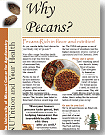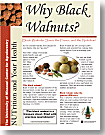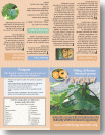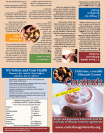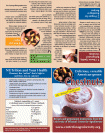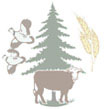Outreach Publications
You can purchase UMCA publications directly from the University of Missouri Extension
online
or you can also print out any of the publications below.
Newsletters
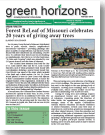
|
Green Horizons Newsletter -- Green Horizons
is a free*, quarterly newsletter produced by the Center
for Agroforestry and a number of sponsors representing Missouri's
forestry and natural resources industries. Articles feature
a variety of topics related to forestry and agroforestry, including
forest health and management; community and urban forestry;
value-added products produced through agroforestry; upcoming forestry
and natural resources events; tree health and care; and new market
opportunities. To subscribe to Green Horizons, contact Michael Gold
(goldm@missouri.edu).
*Due to the higher cost for printing and mailing hard copies of Green Horizons,
please also indicate if you are willing to receive the electronic
version instead of a hard copy edition.
|
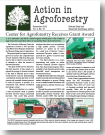
|
Action in Agroforestry newsletter -- Action in
Agroforestry is the monthly newsletter of the MU Center for Agroforestry. It focuses on Center
affiliates and staff and recognizes awards and honors and discusses research, outreach and the
impact of the Center. To subscribe to the newsletter, which is sent electronically, contact
Michael Gold, goldm@missouri.edu or 573-884-1448.
|
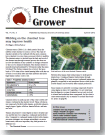
|
The Chestnut Growers Newsletter -- The Chestnut
Growers of America is the western hemisphere's premier organization for chestnut producers,
consumers, retailers and distributors. A diverse membership spanning internationally, as
well as both coasts and the Midwest, helps contribute to articles on chestnut production,
harvesting, marketing and expansion of the industry. The Chestnut Grower newsletter is
published quarterly as a tool for increasing consumer awareness and demand, as
well as landowner production, of this versatile, sweet nut that holds great potential
as a successful cash-crop for Missouri agricultural producers. Although back issues are posted
after one year, the Chestnut Grower is published for members of the Chestnut Growers of America.
To become a member, contact Ray Young, Ray@ChestnutsOnLine.com.
|

General Agroforestry Publications
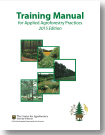
|
Training Manual for Applied Agroforestry Practices - 2015 Edition
Printed in July 2015 to coincide with the 3rd Annual Agroforestry Academy, this updated version of the Agroforestry Training Manual
is designed for natural resources professionals and landowners and includes worksheets and exercises for use as an educational tool.
The manual features descriptions of establishing and managing the five agroforestry practices, plus success stories of Midwestern
landowners utilizing agroforestry on agricultural and forested lands. Additional Chapters include: planning for agroforestry;
wildlife habitat and agroforestry; marketing principles and economic considerations. Appendix sections include tree, shrub, grass and
forage information for agroforestry plantings and timber sales suggestions. For 2015, the Additional Resources section at the end of
each Chapter has been updated and expanded. The pdf version of the Training Manual is available for downloading here.
|
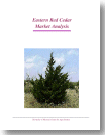
|
Eastern Redcedar Market Analysis (PDF, 1.6 MB)
Text Version
|
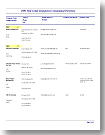
|
Eastern Redcedar Directory (PDF, 34 KB)
Redcedar Market Directory Form (PDF, 63 KB)
Redcedar Mail Survey (PDF, 161 KB)
|
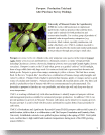
|
Pawpaws Production Trial and After-Purchase Survey (PDF, 407 KB)
|
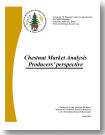
|
Chestnut Market Analysis: Producers' Perspective (PDF, 309 KB)
2006 Market Directory (PDF, 55 KB)
The University of Missouri Center for Agroforestry (UMCA) is conducting research to identify
and describe the chestnut (Castanea spp.) product market value chain. Through detailed market
research and by organizing events that increase consumer awareness towards chestnuts, UMCA's goal is
to broaden market opportunities for all individuals and businesses in the chestnut marketplace. In
2004, UMCA conducted a nationwide survey of individuals and businesses active in the U.S. chestnut
market (nurseries, producers and sellers). The focus of this report is to describe the market from the
producers' perspective.
|
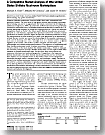
|
A Competitive Market Analysis of the United States
Shiitake Marketplace (PDF, 384 KB)
|
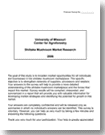
|
Shiitake Mushroom Market Research - Producer Survey (PDF, 61.8 KB)
|
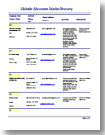
|
Shiitake Mushroom Market Directory (PDF, 34 KB)
|
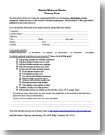
|
Shiitake Mushroom Market Directory Form (PDF, 52 KB)
|
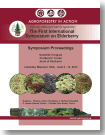
|
Elderberry Symposium Proceedings (PDF, 5.03 MB)
Contains abstracts of the presentations from the First International Symposium on Elderberry. This was the world's first
gathering of international scientists studying all aspects of the elderberry plant and fruit, and its use as a food and dietary
supplement. The Symposium was organized under the auspices of the International Society for Horticultural Science. Research papers
resulting from the Symposium will be published in Acta Horticulturae.
|
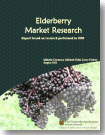
|
Elderberry Market Research Report (PDF, 3.06 MB)
|
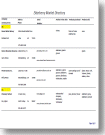
|
Elderberry Market Directory - March 2011 (PDF, 186 KB)
Elderberry Market Directory Form (PDF, 86 KB)
Elderberry Market Research Survey (PDF, 142 KB)
|

Annual Reports
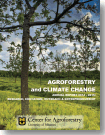
|
2019 Annual Report (PDF, 4.94 MB)
2018 Annual Report (PDF, 6.34 MB)
2016-2017 Annual Report (PDF, 6.92 MB)
2014-2015 Annual Report (PDF, 1.98 MB)
2011 Annual Report (PDF, 5.94 MB)
2010 Annual Report (PDF, 5.91 MB)
2009 Annual Report (PDF, 3.71 MB)
2008 Annual Report (PDF, 2.26 MB)
2007 Annual Report (PDF, 10.9 MB)
2006 Annual Report (PDF, 4.7 MB)
2005 Annual Report (PDF, 3.7 MB)
2004 Annual Report (PDF, 17 MB)
2003 Annual Report (PDF, 2.8 MB)
|

Agroforestry 5-Practices DVD
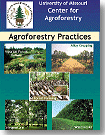
|
The Center for Agroforestry recently completed a DVD integrating the four previously produced
videos on the agroforestry practices of alley cropping, windbreaks, riparian forest buffers and
silvopasture with the fifth practice, forest farming. The new section shows examples of successful
forest farming practices, including shiitake mushroom production, pine straw, woodland wildflowers,
medicinal plants, high value wood blanks and tips for marketing forest farming products. Each DVD
includes all five agroforestry practices and can be purchased for $10. For more information, go to
the Agroforestry 5-Practices page.
|

Agroforestry in Action Series
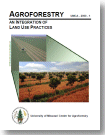
|
Agroforestry: An Integration of
Land Use Practices (PDF, 1.34 MB)
|
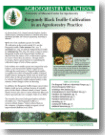
|
Burgundy Black
Truffle Cultivation in an Agroforestry Practice (PDF, 5 MB)
The biology, ecology, cultivation and use of the Burgundy truffle are the subjects of this publication.
|
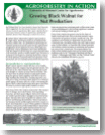
|
Growing Black
Walnut for Nut Production (PDF, 0.98 MB)
Eastern black walnut trees (Juglans nigra) produce high-value, hardwood products and
distinctively flavored, edible nuts. The potential for producing two valuable products from the same
tree has captured the imagination of tree planters for years. While black walnut trees can be grown
for timber and/or nut production, the focus of this guide is toward planting, managing and harvesting
top-quality black walnut nuts for sales at the retail or wholesale level from an orchard practice,
similar to pecan and other nut trees. This guide is a collaborative effort of the nut tree research
cluster at the Center for Agroforestry and the nut research program of Kansas State University and
represents a decade of research on growing black walnut trees in an orchard practice for nut production.
|
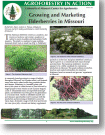
|
Growing and Marketing Elderberries in Missouri (PDF, 5.3 MB)
|
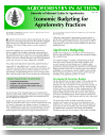
|
Economic
Budgeting for Agroforestry Practices (PDF, 1.13 MB)
|
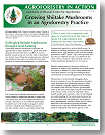
|
Growing Shiitake
Mushrooms in an Agroforestry Practice (PDF, 2.85 MB)
Learn more about shiitake production as a profitable component of forest farming, one of the five
agroforestry practices. Tips for marketing shiitakes, winter production and the success story of
Ozark Forest Mushrooms, a Missouri-based specialty mushroom business, are included in the guide.
|
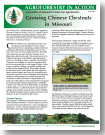
|
Growing Chinese
Chestnuts In Missouri (PDF, 2.3 MB)
|
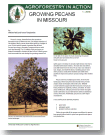
|
Growing Pecans in Missouri (PDF, 1.19 MB)
|
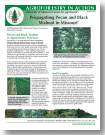
|
Propagating
Pecan and Black Walnut (PDF, 3.13 MB)
|
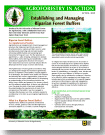
|
Establishing
and Managing Riparian Forest Buffers (PDF, 5.67 MB)
|
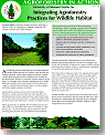
|
Integrating
Agroforestry Practices for Wildlife Habitat (PDF, 2.08 MB)
At the MU Center for Agroforestry, we believe that active and productive farms can also be managed
to support a wide spectrum of wildlife species. With that in mind, the center has created a new
Agroforestry in Action, in cooperation with MU Fisheries and Wildlife Extension Specialist, Dr. Bob
Pierce. This publication gives landowners and farmers ideas on how to incorporate management of trees,
shrubs and grasses with their current farm practices so wildlife will benefit. This publication provides
information on white-tailed deer, eastern wild turkey, bobwhite quail, waterfowl and mourning doves,
briefly describing the needs of each species and providing ideas on how agroforestry can be applied
to help meet habitat requirements and improve the likelihood of a farm keeping populations of the
desired wildlife. More information on any of the wildlife species can be found through the list of
resources at the end of the document.
|
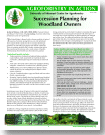
|
Succession
Planning for Woodland Owners (PDF, 1.53 MB)
The U.S. is blessed with a diverse portfolio of natural resources. Not least among them is our vast
timberland. About 42 percent of the nation's forestlands are in private ownership. Mostly, these are
family owned forests. The objectives of these family forest owners vary widely. Whatever their purpose,
these families have a large economic stake in one of America's crown jewels -- its forestland. The
reality is that the vast majority of these privately owned, family forests will change hands over the
next several decades as the current generation of owners ages. Often, the intent is to keep these
important assets in the family for future generations. However, the pressures and realities that
family forest owners face today are likely to prevent this from happening unless steps are taken to
prepare for the transfer. This publication is about helping the current owners of family forestland
ssess their situations and prepare for a successful transition to the next generation of owners.
|
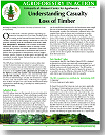
|
Understanding
Casualty Loss of Timber (PDF, 5.44 MB)
One of the most common questions regarding tax treatment of timber has to do with casualty losses --
the damage, destruction or loss of a property resulting from an identifiable event that is sudden,
unexpected or unusual. From a timber investment standpoint, the most common causes of casualty losses
are fires, wind storms, ice storms, vandalism, floods and earthquakes. It is important to understand
that losses in timber due to progressive deterioration, such as fungus, diseases, insects, worms, or
similar pests are typically not considered casualty losses, because they are not sudden, unexpected
or unusual. The IRS allows timberland owners to take a deduction on their Federal income tax return
for casualty losses. Two major tax concepts are involved in determining a casualty loss deduction:
"adjusted basis" and "fair market value." This guide is an explanation of these concepts and two case
studies illustrating their application in determining a casualty loss deduction for damaged timber.
|
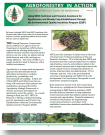 |
Using NRCS Technical and Financial Assistance for Agroforestry and Woody Crop Establishment
(PDF, 6.33 MB)
|

NUTrition and Your Health
Chestnut Recipes - Compiled by Julie Rhoads

Associated Publications
National Agroforestry Center - Contains various
Agroforestry Publications from across the country
Conservation Buffers: Design Guidelines for
Buffers, Corridors, and Greenways
AFTA (Association for Temperate Agroforestry) -
Temperate Agroforestry Text Book

































